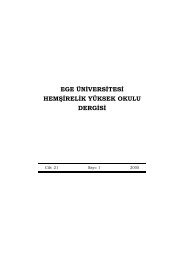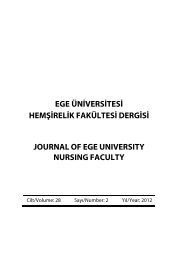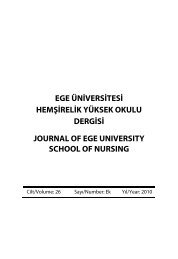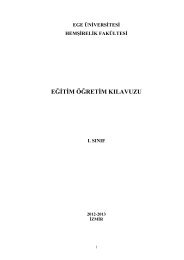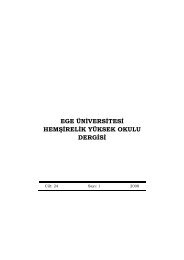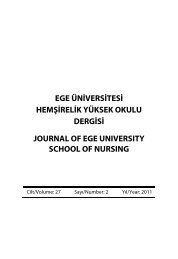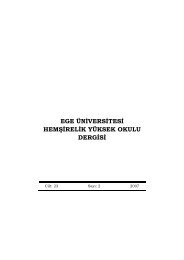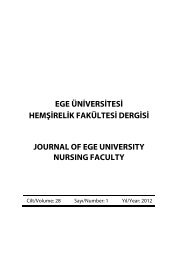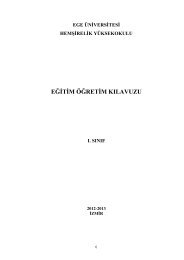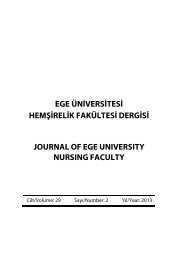E.Ü. HYO Dergisi Cilt 26 - Sayı 2 - 2010 - Hemşirelik Yüksekokulu
E.Ü. HYO Dergisi Cilt 26 - Sayı 2 - 2010 - Hemşirelik Yüksekokulu
E.Ü. HYO Dergisi Cilt 26 - Sayı 2 - 2010 - Hemşirelik Yüksekokulu
You also want an ePaper? Increase the reach of your titles
YUMPU automatically turns print PDFs into web optimized ePapers that Google loves.
ABSTRACT<br />
Objective: The purpose of this study was to analyse examination multiple<br />
choice questions asked in final examination in School of Nursing between 2006<br />
and 2007 years.<br />
Methods: The research is a descriptive and retrospective study. Multiple<br />
choice questions which asked in Nursing and Health I and Nursing and Health II<br />
lessons’ final examinations were evaluated as a whole and then every item’s<br />
difficulty and discrimination indexes were counted.<br />
Data were collected from the exam sheets of 388 students. Nursing and<br />
Health I consisted of five modules and Nursing and Health II three modules. One<br />
hundred eighty eight multiple-choice questions which asked in final examinations<br />
were analyzed.<br />
First, questions are evaluated as a whole. Difficulty index (p) and<br />
discrimination index (r) were determined using a Microsoft Excel computer program<br />
with some formulas according to suggestions made by Kelley. Because of<br />
analyzing item, every item’s difficulty and discrimination indexes were counted.<br />
Results and Conclusion: As a result, it was determined that examination<br />
questions of Nursing and Health II were more easy (the difficulty index was low)<br />
and rate of good items were higher (the discrimination index was high) than<br />
Nursing and Health I. “Should be corrected” and “should be extracted” items were<br />
high in both examinations.<br />
Key Words: Final examination, multiple choise question, difficulty index,<br />
discrimination index<br />
GİRİŞ<br />
Eğitim, insanın davranışlarında kendi yaşantısı yolu ile istendik<br />
yönde değişiklikler meydana getirme sürecidir (Yılmaz 2002 a). Eğitim<br />
süreci içinde ölçme ve değerlendirme ile, hedef davranışların ne kadarının<br />
gerçekleştirildiği veya gerçekleştirilemediği görülür (Bilen 2002, Sullivan<br />
ve ark. 1994). Ölçme ve değerlendirme faaliyeti sayesinde amaçlar ve<br />
hedef davranışlar yeniden gözden geçirilerek, doğru ve etkili geri<br />
bildirimler verilebilir (Vaughan 1992, Yılmaz 2002 a, Yılmaz 2004 b).<br />
Öğretim yönteminden, öğrenme ortamından, dersin içeriğinden ve diğer<br />
faktörlerden kaynaklanan ve öğrenmeyi olumsuz yönde etkileyen<br />
değişkenler tespit edilebilir ve düzeltilebilir (Eskiocak ve ark. 2004,<br />
Fidan ve Erden 2007). Öğretim sonrası öğrencinin kazandığı bilginin<br />
derecesini belirlemek için test araçları ve materyalleri geliştirilir (İşmen<br />
ve Eskicumalı 2000, Kemp ve ark. 1998).<br />
Testler, bireylerin belli özelliklerini ölçmek için düzenlenen ve<br />
herkes için aynı olan sorulardan oluşan bir ölçme aracıdır.<br />
Değerlendirmenin hatasız ya da az hatalı olması, değerlendirmede<br />
kullanılan ölçümlerin değerlendirme amacı ile ilgili ve o amaç için<br />
yeterli olmasını ve uygun bir ölçüt seçilmesini gerektirir (Eskiocak ve<br />
ark. 2004).<br />
38




